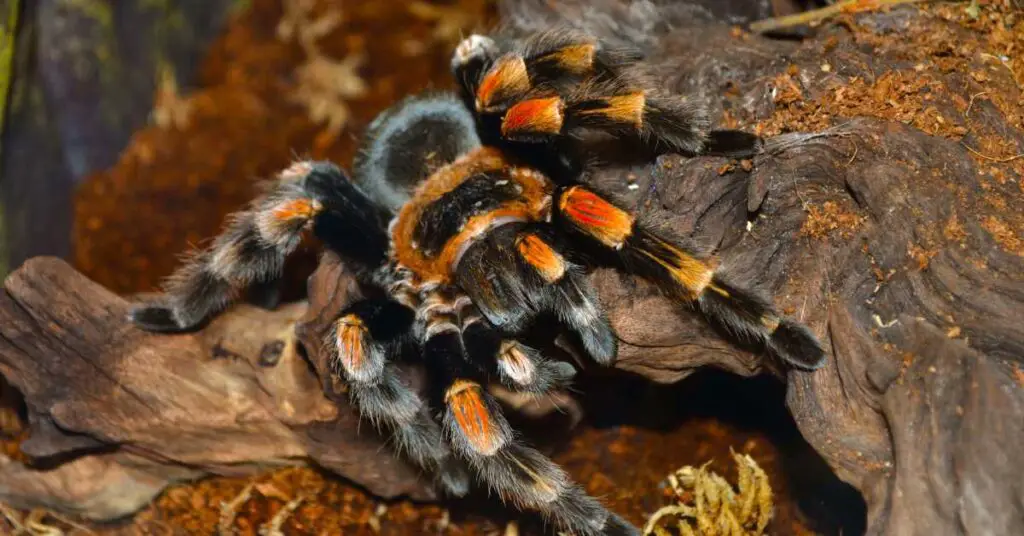Did you know that tarantulas have a surprisingly diverse diet? These eight-legged creatures have an appetite for more than just insects. While they do enjoy feasting on various creepy crawlies, their menu also includes small reptiles, birds, rodents, amphibians, and even other spider species.
But what exactly makes up a tarantula’s daily meal? Well, you’re about to find out. So, buckle up and prepare to uncover the fascinating world of tarantula cuisine.
Key Takeaways
- Tarantulas primarily feed on insects such as crickets, grasshoppers, beetles, and moths.
- Larger tarantula species may also feed on small vertebrates like frogs, lizards, and small birds.
- Tarantulas may resort to cannibalism, especially when food sources are scarce, with juvenile tarantulas engaging in cannibalism to obtain protein and energy.
- While tarantulas are primarily carnivorous, there have been rare reports of them consuming plant matter such as fruits and nectar, although this behavior is not a significant aspect of their nutrition and feeding habits.
Insects
What types of insects make up the main diet of tarantulas? Tarantulas are predators that primarily feed on insects as a part of their diet. These arachnids have developed unique hunting techniques to capture their prey efficiently. Tarantulas are known to consume a wide variety of insects, including crickets, grasshoppers, beetles, and moths. They’re opportunistic feeders and will consume any insect that they can overpower.
Tarantulas use a combination of stealth and agility to hunt their prey. They’ve excellent eyesight, which allows them to detect movement and spot potential prey from a distance. Once they locate their target, tarantulas use their powerful legs to pounce on their unsuspecting victims. They immobilize their prey by injecting venom through their fangs, which paralyzes the insect and begins the digestion process.
Tarantulas are solitary creatures that rely on their hunting techniques to secure their food source. They patiently wait for their prey to approach, using camouflage to blend into their surroundings. When the opportunity arises, tarantulas strike with lightning speed, ensuring a successful catch.

Small Reptiles
As tarantulas primarily feed on insects, it’s essential to explore their diet further to understand if small reptiles also play a role in their food consumption. While tarantulas are known to be opportunistic predators, their feeding habits regarding small reptiles are relatively rare and limited. Tarantulas typically prefer to prey on smaller animals that are easier to capture, such as insects and other arthropods. Their venom and fangs are specifically adapted for immobilizing and digesting soft-bodied creatures.
Although tarantulas have been observed feeding on small reptiles in the wild, such instances are infrequent and mostly occur in areas where their usual prey is scarce. Small reptiles, such as lizards and geckos, have a greater chance of falling victim to a tarantula if they venture too close to the spider’s burrow or are caught off guard. However, it’s important to note that these occurrences aren’t common and shouldn’t be considered as a regular part of a tarantula’s diet.
Birds
Tarantulas rarely prey on birds due to their limited ability to capture and subdue these agile creatures. While tarantulas are known for their formidable hunting skills, birds present unique challenges that make them less desirable as avian prey. Here are four reasons why tarantulas rarely hunt birds:
- Size and speed: Birds are generally larger and faster than the typical prey of tarantulas, such as insects and small reptiles. Their quick movements and ability to take flight make them difficult targets for tarantulas to catch.
- Feathers as defense: Birds have feathers that can help protect them from potential predators. These feathers not only provide insulation and aid in flight but can also make it harder for a tarantula to gain a firm grip on the bird’s body.
- Avian hunting techniques: Birds have evolved various hunting techniques, such as aerial acrobatics and swooping dives, that allow them to catch their own prey. These tactics make it challenging for a ground-dwelling tarantula to successfully ambush a bird.
- Habitat differences: Tarantulas primarily inhabit terrestrial environments, while many bird species dwell in the air or high up in trees. This habitat disparity further limits the encounters between tarantulas and birds.
Despite these challenges, it isn’t entirely impossible for tarantulas to occasionally prey on small, ground-dwelling birds. However, such instances are exceedingly rare and not a significant part of their diet.
Rodents
Rodents serve as a significant part of the tarantula’s diet due to their abundance and accessibility in terrestrial environments. Tarantulas exhibit predatory behavior towards rodents, making them an essential food source for these arachnids. Tarantulas are skilled hunters and employ various feeding habits when it comes to capturing and consuming rodents.
When hunting rodents, tarantulas primarily rely on their powerful venom and stealthy approach. They patiently wait for the perfect opportunity to strike, using their sharp fangs to inject venom into their prey. The venom immobilizes the rodent, allowing the tarantula to overpower and subdue it.
Once the rodent is incapacitated, the tarantula uses its specialized mouthparts to tear into the flesh and consume the prey. Tarantulas have strong digestive systems that can break down the tough tissues of rodents, extracting the necessary nutrients for their survival.
Feeding on rodents provides tarantulas with a substantial source of protein, aiding in their growth and development. These arachnids have adapted to thrive in a wide range of environments, and the availability of rodents contributes to their success as predators.
Amphibians
Amphibians, another crucial component of the tarantula’s diet, offer a diverse and nutritionally valuable food source for these arachnids in their quest for sustenance and survival. As fascinating creatures, amphibians play a vital role in the ecosystem and their conservation is of utmost importance.
Here are four key points to consider when exploring the relationship between tarantulas and amphibians:
- Dietary Variety: Tarantulas consume a wide range of amphibians, including frogs, toads, and salamanders. This diversity in diet ensures that tarantulas receive a balanced nutritional intake, allowing them to thrive.
- Amphibian Life Cycle: Understanding the life cycle of amphibians is crucial in comprehending their significance as tarantula prey. From eggs to tadpoles and finally to adult amphibians, each stage presents different opportunities for tarantulas to hunt and feed.
- Ecological Balance: Tarantulas, by consuming amphibians, help maintain the delicate balance of the ecosystem. By controlling amphibian populations, tarantulas prevent overpopulation and ensure the health and survival of other species in their habitat.
- Amphibian Conservation: As amphibians face various threats such as habitat loss and pollution, their conservation is essential. By recognizing the importance of amphibians in the diet of tarantulas, we can contribute to their conservation efforts and protect these unique creatures for future generations to appreciate.
Understanding the role of amphibians in the tarantula’s diet provides valuable insight into the intricate web of life. By appreciating the interconnectedness of all species, we can foster a sense of belonging and strive towards a more sustainable future for both tarantulas and amphibians alike.
Other Spider Species
The dietary preferences of tarantulas extend beyond their own species to include a wide range of other spider species, contributing to the intricate dynamics of their food web. Tarantulas are known to prey on various types of spiders, such as orb weavers, wolf spiders, and jumping spiders. These different spider species play important roles in the ecosystem, and their consumption by tarantulas helps regulate their populations.
Spider web construction is a fascinating aspect of spider behavior. Different spider species construct different types of webs, including orb webs, sheet webs, and funnel webs. Tarantulas are opportunistic hunters and are able to navigate and move through these webs without getting entangled. They use their specialized hairs on their legs to detect vibrations and movements in the web, allowing them to approach their prey undetected.
Spider mating behaviors are also diverse and unique to each species. Male spiders often display elaborate courtship rituals to attract females. They may use visual displays, vibrations, or chemical signals to communicate their intentions. Tarantulas, being predators, aren’t involved in these courtship behaviors. However, female tarantulas may consume male spiders after mating in certain species. This behavior is believed to provide the female with extra nutrition for egg development.
Tarantula-Specific Diets
Tarantulas have a highly specialized diet consisting primarily of insects and other arthropods. Their unique feeding habits are adapted to their specific nutritional needs. Here are some key aspects of tarantula nutrition and feeding habits:
- Insects: Tarantulas are voracious insectivores, feeding on a wide variety of insects such as crickets, grasshoppers, beetles, and moths. These small arthropods provide essential protein, vitamins, and minerals necessary for their growth and overall health.
- Small vertebrates: Some larger tarantula species have been observed feeding on small vertebrates like frogs, lizards, and even small birds. These unusual prey items supplement their diet with additional nutrients and energy.
- Cannibalism: In certain circumstances, tarantulas may resort to cannibalism, especially when food sources are scarce. This behavior is more common among juvenile tarantulas and can provide them with a source of protein and energy to survive.
- Occasional plant matter: Although tarantulas are primarily carnivorous, there have been rare reports of tarantulas consuming plant matter such as fruits and nectar. However, this behavior isn’t well-documented and is considered to be more of an exception rather than a regular part of their diet.
Understanding the unique nutritional requirements and feeding habits of tarantulas is crucial for their care in captivity. Providing a varied diet that mimics their natural prey items is essential for their health and well-being.
Frequently Asked Questions
How Often Do Tarantulas Need to Eat?
Tarantulas, like any other living creature, have specific dietary needs. The feeding frequency of tarantulas varies based on their age and species. Overfeeding can pose health risks, so it’s important to understand their specific requirements.
Can Tarantulas Eat Fruits or Vegetables?
Tarantulas, despite being carnivorous, do not typically consume fruits or vegetables. Their diet consists mainly of insects, small mammals, and other arthropods. These creatures thrive on a diet rich in protein and fats.
Do Tarantulas Drink Water or Get Hydration From Their Food?
Tarantulas need a water dish to stay hydrated as they do not get enough moisture from their food. They drink water by lapping it up with their mouthparts, and it is important to provide them with fresh water regularly.
Are There Any Specific Plants or Flowers That Tarantulas Can Eat?
Tarantulas can eat certain carnivorous plants. Incorporating these plants into their diet can have a positive impact on their overall health and lifespan. It is important to provide a varied diet to ensure their well-being.
Is It Necessary to Provide Live Prey for Tarantulas, or Can They Eat Pre-Killed Insects?
You can feed tarantulas pre-killed insects, but providing live prey has pros and cons. Live prey allows for natural hunting behavior, but there are potential alternatives like freeze-dried insects that can provide nutrition without the need for live prey.
Conclusion
In conclusion, tarantulas have a varied and opportunistic diet, feeding on a wide range of prey including insects, small reptiles, birds, rodents, amphibians, and even other spider species.
Their diet is adaptable and can be influenced by their environment and availability of food sources.
Tarantulas have specialized feeding strategies and mechanisms to capture and consume their prey, making them successful predators in their ecosystems.
Further research is needed to explore the specific nutritional requirements and preferences of different tarantula species.


